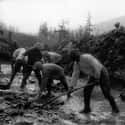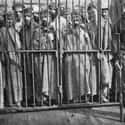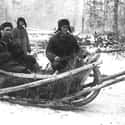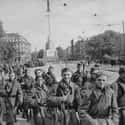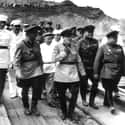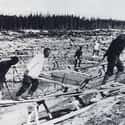-
(#5) The Gulag Was A Slave Labor Front
During interrogation, anyone who was arrested was often given bogus reasons for their arrest. These absurd reasons included the usual list of treasonous acts like spying, economic sabotage, anti-revolutionary activity, or - after the 1930s - being sympathetic to enemies of the state such as the Kulaks. While these were some of the reasons given, they masked the true reason that many people were arrested: their economic value.
After Joseph Stalin initiated his five-year plan to rapidly modernize the Soviet Union, the government needed laborers to work on huge construction and industrial projects. It also quickly realized that there was a lack of knowledgeable and skilled specialists. So a steady stream of arrests and the deportation of hundreds, then thousands, of people year after year fed the Gulag, which then, with the aid of its slave labor, built Stalinist Russia.
Gulag camp guards had control over every aspect of a prisoner's existence. If a guard was in a good mood or bad mood, that could determine how much a prisoner ate, what clothes they could wear, and where they slept.
-
(#4) Inmates Killed One Another Over Food And Shoes
Soviet society - and Stalin himself - considered Gulag prisoners, regardless of background or lack of guilt, as cogs in the great machine of socialist advancement towards communism. Known as "zeks," a Russian slang term for prisoners, the inmates were considered valueless and treated a such.
While interned, prisoners were issued rations that included rudimentary clothing, the occasional eating utensil, and scant amounts of low-protein food. This, combined with the long hours of labor, caused inmates to be simultaneously starved and worked to death along with suffering from disease and exposure.
Fights broke out over food, and some prisoners became hoarders of basic items. Tobacco, food, sewing needles, and even shoes and sweaters were traded within a strict and lethal inmate hierarchy. Protection was bought, gambling occurred, debts were paid, and prisoners took each other's lives over simple sundries. Within the camp administration, food was used as both an incentive to work harder and as a weapon.
-
(#9) Camp Living Conditions Provided Almost No Basic Needs
Daily life in the camps was reflective of the seasons and geographic locations of the Gulags. For example, camps north of the Arctic Circle were bleak most of the time while camps close to the Chinese border were a bit more tolerable (weather-wise, that is).
All camps, however, had hard labor, very little food, disease, a lack of basic amenities, and the constant threat of death in common. Barracks were often nothing more than wooden shacks, and the only clothing that was issued to prisoners were padded jackets and, if you were lucky, trousers, caps, and mittens. Food was bland and infrequent, and, because of the lack of nutrition, diseases and work accidents were common causes of injuries and death.
-
(#11) Prisoners Were Sent To The WWII Battlefront To Atone For Their Crimes
During WWII, Stalin and Vyacheslav Molotov issued Order No. 227, in which one particular clause transferred Gulag prisoners to special penal battalions in the Red Army to serve on the Eastern Front. The penal battalions were assigned the most dangerous missions to "atone" for their crimes.
An example of this dangerous work was to cross a minefield to clear it of explosives by sacrificing yourself so that regular battalions could safely cross over afterward. Placed behind the penal battalions were blocking units, groups of soldiers whose orders were to fire on anyone retreating.
On some level, even Stalin must've understood the abject craziness of this dictum, seeing as he wouldn't let it be put into print and had it disseminated solely by word of mouth instead.
-
(#8) Gangs Ruled The Gulag
While many in the Gulag were totally innocent, bandits, thieves, murderers, and other traditional criminals could also be found inside. Like basically every other imprisonment situation that has ever happened, these real, hardened criminals became camp elites who wielded power through terror over their non-lawbreaking fellow inmates. Criminals were often known by clan-specific tattoos that were related to Russian Orthodoxy and culture. Tattoos had meanings that were Gulag specific and differed from era to era.
While in the camps, gangs controlled essentially every aspect of social life. Communication, protection, who did hard labor, intimacy, who slept and lived where, food rationing, and punishment were all things left up to the Gulag gangs.
And gang punishment for an infraction was often violent and unforgiving. In fact, fear of retribution from a gang member was greater than retribution from guards. If a prisoner broke a rule or code of conduct, the offender could expect to be subjected to beatings, knifings, bludgeoning, deprivation of food, intimidation, sexual assault, more hard labor than usual, clothing and food fines, and even murder.
-
(#2) Prisoners Were Worked To Death All The Time
The vast majority of Gulag inmates were not skilled laborers. Around 18 million prisoners entered the Gulag, so a wide, diverse range of professions was represented, which meant that people with formerly niche or white-collar occupations suddenly found themselves doing back-breaking manual labor. Many were innocent of any crime and were simply there as a result of random arrests to fill the slave-labor needs demanded by Stalin and his inner circle.
Doctors, educators, factory workers, craftspeople, farmers, soldiers, students, artists, and writers were arrested and sent to penal colonies constantly, but the prison population and size of the Gulag system expanded and increased greatly in four distinct periods. Camps required labor based on their location, so, for example, camps in forests had prisoners fell trees, while camps near tin or other alloy deposits forced inmates to mine for metals.
While working, prisoners were not given safety clothing or heavy equipment to complete their tasks. Often they only had their winter clothing and primitive hand tools to dig or build complex projects in the freezing Siberian elements. It's no wonder, then, that people perished from exhaustion and the elements all the time.
New Random Displays Display All By Ranking
About This Tool
Gulag Prison is the most notorious prison system in Soviet history. Prisoners were beaten and tortured there, but some survived. This nauseating and cruel forced labor system was first established after the Russian Civil War. By the 1950s, the labor camps had covered the entire Soviet territory, it can be said one of the darkest periods in the history of the 20th century.
In the Gulag camp, the prisoners did not have safety guarantees or equipment to complete their tasks. They even excavate or build complex projects in cold Siberia only with winter clothes and original tools. It is not surprising that people always die from fatigue and cold. The random tool lists 13 facts about life in Soviet Gulag.
Our data comes from Ranker, If you want to participate in the ranking of items displayed on this page, please click here.











